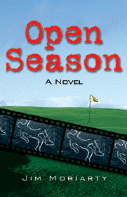Open Season
Based on some of the story lines in Jim Moriarty’s new golf murder mystery, I’m going to try to stay on his good side.
For those involved with golf in a journalistic or professional capacity of some kind, there are some potentially brutal consequences if you don’t.
Moriarty is a long-time golf writer and photographer for magazines such as Golf World and Golf Digest. He uses that experience to provide several keen insights into the behind-the-scenes elements of professional golf.
In this case, however, there’s the added feature of a psychotic serial killer stalking some of the more famous golfing venues, including the Masters, the Hilton Head tournament, and Pinehurst, North Carolina, host of this year’s U.S. Open.
His protagonist, Nick Oliver, is a golf photographer with a keen sense of how others have hurt him in the past, and a diminished understanding of his own ability to hurt others. Oliver had drifted away from the sport for a while after an ugly divorce from a PGA Tour staffer, but he takes an assignment to work with a young photographer from one of those new men’s magazines to shoot the Masters.
Moriarty captures well the frustrations that fill most of the moments of any photographer trying to cover a wide-ranging sports event on a tight deadline. Being in the right place at the right time to capture the moment that best defines the competitive experience always requires a large dose of luck, not always in good supply.
The fact that his partner is only fitfully responsible simply adds to Oliver’s worries.
An unexpected champion’s performance leads to an additional assignment for the next week’s tournament at Hilton Head. Before Oliver leaves Augusta, however, he encounters a brutal murder scene near his hotel room. Exhibiting the serendipity that often plagues the heroes of murder mysteries, Oliver manages to come across another awful murder shortly after he reaches the coast, under circumstances that seem all too related to the death he just left behind.
Oliver sees a potential story developing, and begins to work on that angle along with his formal assignments. Adding to the tension is the fact that the Tour photography also requires him to reconnect with his ex-wife, as well as the man he believes is responsible for his marriage break-up.
Complications ensue, as they say, with a story line that is frequently gripping and realistic.
In addition, a subplot concerning Internet sports gambling also crops up, with a Tour connection that would crush the sport if its basic elements were true. It also looks like Moriarty uses this book to settle a few scores, or at least to sound a brutally funny satirical note or two about the Tour and the characters around it.
One golf writer is described as having “thighs that were the size of country hams, wrapped in khaki.” A former champion-level golfer and current “roly-poly” television announcer from Great Britain is now working for a U.S. broadcaster, “where his accent alone was worth ten rating points.”
Here’s how Moriarty portrays the press room action at the Open:
The daily columnists end up laboring well past sunset, tapping out their witticisms on obsolete laptops provided by newspapers that are reluctant to cover their expenses. They toil as all modern writers do, in the hopes of one day becoming a television personality so they won’t have to write at all. If F. Scott Fitzgerald were alive today, he’d be a regular on 20/20.
Meow.
The comic relief provided by these passages is frequently welcome, however, because Moriarty succeeds in creating several moments of tension-filled dread at the same time.
I don’t often admit to being really creeped out by a fictional character, but this particular serial killer did it for me.
Moriarty also worked out a logical resolution for his story, in a way that leaves open the possibility for a sequel. I hope he has one in him.
Review date: March 5, 2005


